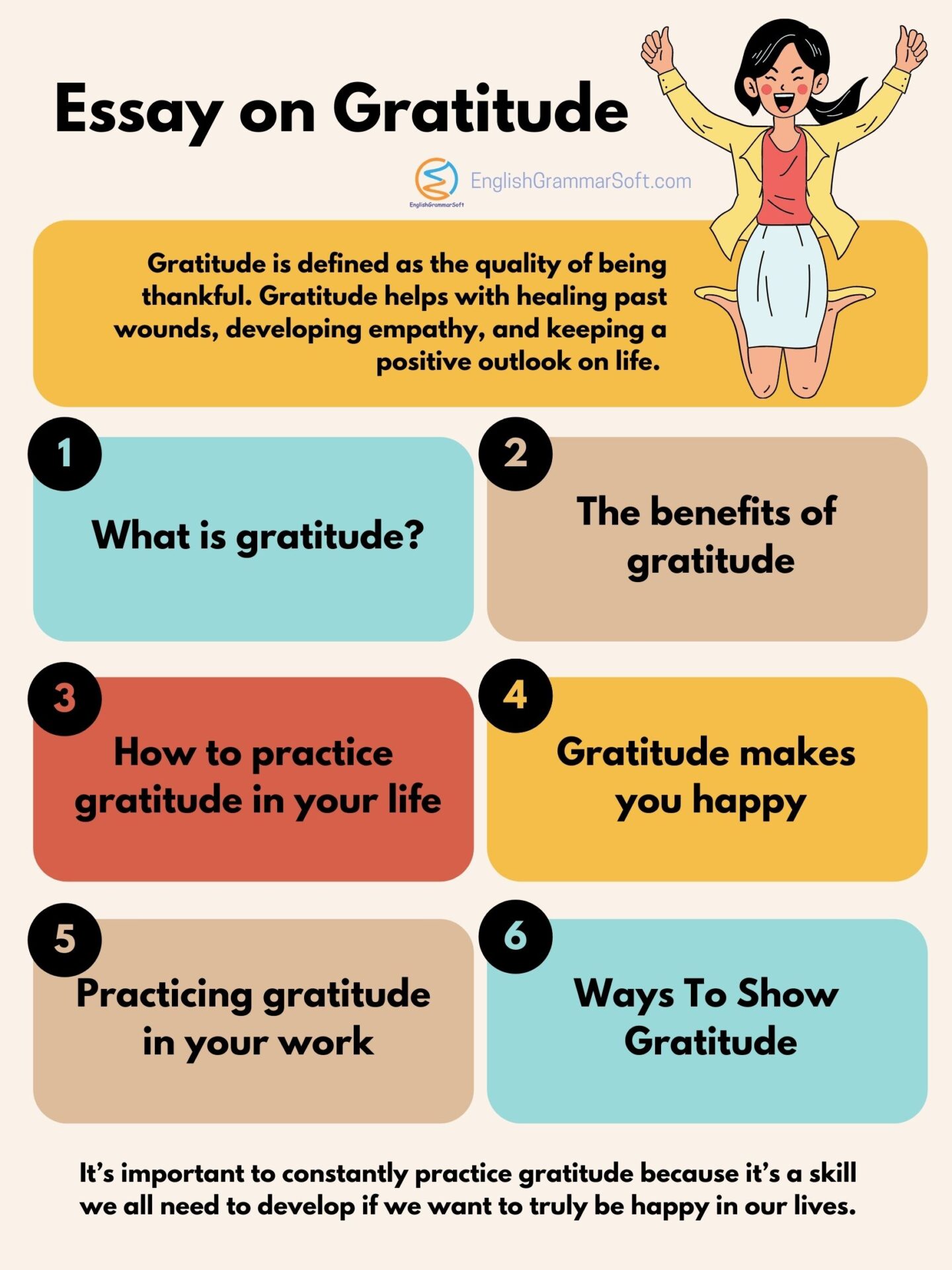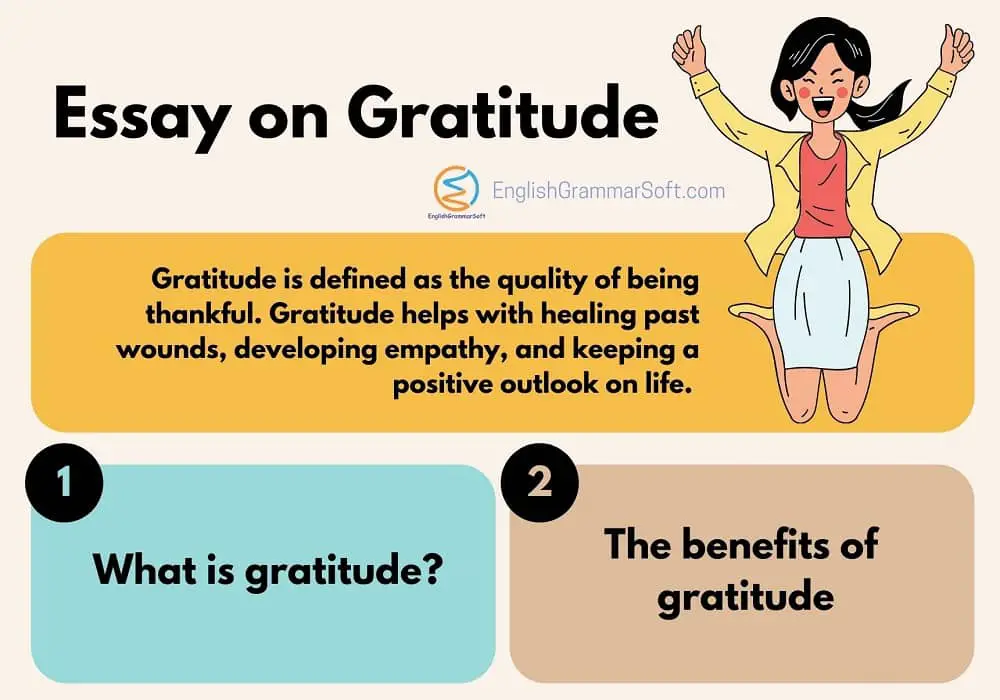Essay on Gratitude (it brings happiness in life)
Essay on Gratitude
Gratitude is an essential virtue, and it makes people happier. Yet what does gratitude mean? What does it look like? In this essay, I will explore the power of gratitude and how you can cultivate it in your life.
1) What is gratitude?
Gratitude is defined as the quality of being thankful. Gratitude helps with healing past wounds, developing empathy, and keeping a positive outlook on life.
This is because gratitude emphasizes the good in life and fosters an appreciation for what you have. It can also decrease feelings of depression, stress, and anger.
Gratitude also leads to greater personal growth by helping you see your flaws with more clarity. It can even lead to success!
It is a feeling of appreciation, and it can make your life more joyful. It’s about looking for the good in your life rather than focusing on the negative.
It can even be a powerful antidote to stress and depression. You don’t need any special skills to practice gratitude, but you do need to remember these five steps:
- Notice what you’re grateful for
- Think about how it makes you feel
- Express gratitude verbally and mentally
- Practice giving back
- Repeat
2) The benefits of gratitude
When you practice gratitude, you can experience increased self-esteem and resilience. For example, people who are in the habit of expressing gratitude have been shown to have more optimism and can think more optimistically.
Gratitude can improve your physical health because it helps you cope with stress. Studies have shown that gratitude improves your immune system, decreases blood pressure, and boosts happiness levels. You may even be able to live longer just by being grateful!
The positive effects of gratitude can be experienced both psychologically and physiologically. With a grateful mindset, you’ll feel more positive about yourself and life in general. You’ll have increased energy levels, improved sleep, and a stronger immune system.
3) How to practice gratitude in your life
Let’s break down each component of practicing gratitude:
- Observing: “Where I am right now is where I am meant to be.”
- Identifying: “I see that I am now in my body and my body is here for me to learn from.”
- Receiving: “I am taking care of my body with nourishment, exercise and rest.”
- Expressing: “I am learning from this experience and sharing it with others.”
- Practicing: “I am grateful for the opportunity to enjoy my life.”
4) Gratitude makes you happy
Gratitude is an action, not a feeling, and there are scientific studies that prove it. Researchers at the University of California recently found that people who report higher levels of gratitude report feeling happier than those who don’t.
When researchers asked participants to recall some of their happiest memories, those who had more positive memories were more likely to say they felt happy than those who had sad ones.
The benefits of gratitude don’t end there. Regular practice can lead to better relationships and a more positive outlook on life. In a recent poll of more than 3,000 Americans, happiness expert Adam Grant found that many of the people who said they were the happiest had what you might think are positive traits—for example, they were more helpful and forgiving.
5) Practicing gratitude in your work
I believe that some of the best jobs that people can have are teaching others about gratitude and encouraging others to look for the good in their lives.
They can do so by teaching an ethics-based curriculum to teach students how to find the good in their lives.
These teachers do so by focusing on the fact that life has more to offer than bad or unhappiness, and by focusing on what’s good in their lives and how to be grateful for it.
6) Ways To Show Gratitude
You don’t need a lot of money, time, or effort to make your life happier and healthier. Here are different easy ways to start practicing gratitude.
- Notice the good: Let’s start with the easiest place to start — noticing the good things that happen in your life. This is a very simple exercise and it will take less than five minutes a day to notice things. As you do this, you may discover something positive about every day and this will remind you how lucky you are.
- Think about how it makes you feel: Next, stop thinking about how you feel when you observe your blessings. You’ll be practicing gratitude and if you’re thinking about how you feel, you won’t be aware of your blessings.
7) Conclusion
Gratitude is not just feeling happy or lucky to have received something; it’s appreciation and acknowledgment of what you have been given.
Gratitude is a quality that most people see as a positive attribute, but it’s not always easy to live by. Sometimes we can be too embarrassed or shy to share our gratitude with others, or we don’t know how to put into words what we’re grateful for.
It’s important to constantly practice gratitude because it’s a skill we all need to develop if we want to truly be happy in our lives.
Keeping a gratitude journal is a great way to practice gratitude, and if you have an electronic device with a camera, you can take a picture of a leaf and put it in your journal to count your blessings.

More on essays
- How to Write an Essay | Structure of Essay (Comprehensive Guide)
- Essay on Happiness is a State of Mind
- Essay on Education
- Essay on importance of education
- An Essay on School Life
- Essay on Friendship
- Essay about Anxiety and Stress
- Essay on Time Management
- Essay on 7 Cs of Communication
- Essay on 8 Business Functions
- Essay on Social Media and Its Impact
- Essay on Personality Development
- Essay on Leadership
- Essay on Importance of water in life
- Essay on Pollution
- Essay on Environment Protection
- Essay on Corruption
- Essay on Why Trees are Important in our Life
- 500 Words Essay on Nature in English
- Essay on Global Warming Causes and Effects
- Essay on Deforestation
- Essay on Smoking is bad for health
- A Short Essay on Mothers Day
- Essay on Health is Wealth






